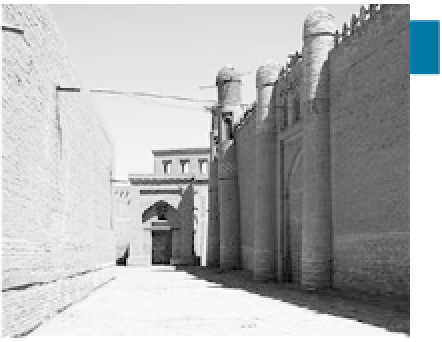Travel Reference
In-Depth Information
as Russia's hopes in the war plummeted, the tsar demanded men. Lo-
cal people in the colonies were to be conscripted as noncombatants in
labour battalions. To add insult to injury, the action was not called 'mo-
bilisation' but 'requisition', a term usually used for cattle and material.
Exasperated Central Asians just said no. Starting in Tashkent, an up-
rising swept eastwards over the summer of 1916. It gained in violence,
and attracted harsher reprisal, the further east it went. Purposeful at-
tacks on Russian militias and official facilities gave way to massive riot-
ing, raiding and looting. Colonists were massacred, their villages burned,
and women and children carried off.
The resulting bloody crackdown is a milestone tragedy in Kyrgyz and
Kazakh history. Russian troops and vigilantes gave up all pretence of a
'civilising influence' as whole Kyrgyz and Kazakh villages were brutally
slaughtered or set to flight. Manhunts for suspected perpetrators con-
tinued all winter, long after an estimated 200,000 Kyrgyz and Kazakh
families had fled towards China. The refugees who didn't starve or freeze
on the way were shown little mercy in China.
Revolution & Civil War
For a short time after the Russian Revolution of 1917, which toppled the
tsar, there was a real feeling of hope in some Central Asian minds. The
Central Asian society which the West, out of ignorance and mystification,
had labelled backward and inflexible had actually been making prepara-
tions for impressive progress. The Young Bukharans and Young Khivans
movements agitated for social self-reform, modelling themselves on the
Young Turks movement which had begun transforming Turkey in 1908.
The Jadidists, adherents of educational reform, had made small gains
in modernising Uzbek schools, despite objections from the conservative
khanate officials.
In 1917 an independent state was launched in Kokand by young na-
tionalists under the watchful eye of a cabal of Russian cotton barons. This
new government intended to put into practice the philosophy of the Jadid
movement: to build a strong, autonomous Pan-Turkic polity in Central
Asia by modernising the religious establishment and educating the peo-
ple. Within a year the Kokand government was smashed by the Red Ar-
my's newly formed Trans-Caspian front. More than 5000 Kokandis were
massacred after the city was captured. Central Asians' illusions about
peacefully coexisting with Bolshevik Russia were shattered.
Bolshevik Conquest
Like most Central Asians, Emir Alim Khan of Bukhara hated the godless
Bolsheviks. In response to their first ultimatum to submit, he slaugh-
tered the Red emissaries who brought it and declared a holy war. The
For more on
Nazaroff's
cat-and-mouse
exploits on the
run in Central
Asia from the Bol-
sheviks, read his
Hunted Through
Central Asia
.
1920
Soviet troops seize
Khiva and Bukhara, re-
placing the respective
khanate and emirate
with People's Soviet
Republics.
1920-26
Basmachi rebel
movement in Central
Asia reaches a peak,
with as many as
16,000 armed men
ighting the Soviet
army.
¨
Khiva, Uzbekistan






